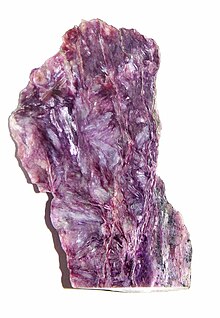| Charoite | |
|---|---|
 | |
| General | |
| Category | Silicate mineral |
| Formula (repeating unit) | K(Ca,Na) 2Si 4O 10(OH,F)•H 2O |
| IMA symbol | Cha[1] |
| Crystal system | Monoclinic |
| Crystal class | Prismatic (2/m) (same H-M symbol) |
| Space group | P21/m |
| Identification | |
| Color | Violet, lilac, light brown |
| Crystal habit | Fibrous, massive |
| Cleavage | Good in three directions |
| Fracture | Conchoidal |
| Mohs scale hardness | 5 - 6 |
| Luster | Vitreous to pearly |
| Streak | White |
| Diaphaneity | Translucent |
| Specific gravity | 2.54 - 2.58 |
| Optical properties | Biaxial (+) |
| Refractive index | nα = 1.550 nβ = 1.553 nγ = 1.559 |
| Birefringence | 0.009 |
| Ultraviolet fluorescence | Weakly fluorescent |
| Common impurities | Al, Fe, Mn, Sr, Ba |
| Other characteristics | |
| References | [2][3][4][5] |
Charoite (/tʃæroʊ.aɪt/ CHAR-ow-ait) is a rare silicate mineral with the chemical composition K(Ca,Na)
2Si
4O
10(OH,F)•H
2O, first described in 1978. It is named after the Chara River, despite its being 70 kilometres (43 mi) away from the discovery place.[6][3] When it was discovered, it was thought to be a fake, dyed purple to give it its striking appearance.[7]
- ^ Warr, L.N. (2021). "IMA–CNMNC approved mineral symbols". Mineralogical Magazine. 85 (3): 291–320. Bibcode:2021MinM...85..291W. doi:10.1180/mgm.2021.43. S2CID 235729616.
- ^ Mineralienatlas
- ^ a b Barthelmy, David (2014). "Charoite Mineral Data". Webmineral.com. Retrieved 2022-04-12.
- ^ Charoite, Mindat.org, retrieved 4 July 2022
- ^ Anthony, John W.; Bideaux, Richard A.; Bladh, Kenneth W.; Nichols, Monte C. (2005). "Charoite" (PDF). Handbook of Mineralogy. Mineral Data Publishing. Archived from the original (PDF) on 7 November 2022. Retrieved 4 July 2022.
- ^ Ian Frazier, Travels in Siberia, Farrar, Straus and Giroux, New York (NY), 2010, ISBN 978-0-374-27872-4, page 394
- ^ "Charoite Meaning, History and Detailed Information with Photos". Cape Cod Crystals. Retrieved 2022-04-12.